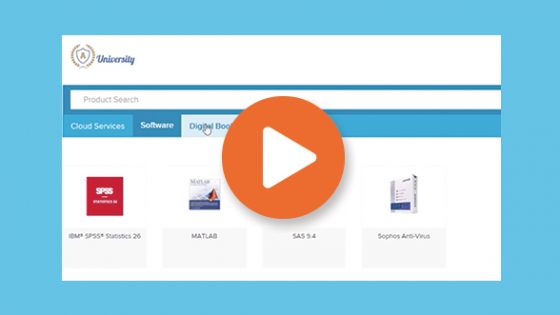This year’s UB Tech® conference saw representatives from the higher-ed and tech industries discussing how to best leverage technology in classrooms. Our own Ryan Peatt – Chief Product Officer at Kivuto – took the stage to deliver a presentation called: Consolidate, Centralize & Save: Strategic Software Licensing Approaches.
Ryan’s talk included a look back on key developments that have shaped the relationship between technology and education over the past 21 years. He also established how these changes – particularly the most recent one – have contributed to making digital license management the headache for higher-ed IT teams that it is today.
Read on for a summary of how software license management in higher education got where it is today – and why where it is today is so complex.
Want more than a summary?
Check out Ryan’s full UB Tech 2019 presentation.
Watch The Video
A Brief History of Technology in Education
Technology is always in flux. This isn’t new or unique to education; it’s been a universal truth since computers first started to supplant pens and paper. However, the education sector has been uniquely impacted by shifting trends in technology – and the most recent shift, in particular, has created challenges that schools are still working out how to handle.
At UB Tech, Ryan highlighted the three changes that most significantly affected the use of technology in education over recent decades.
1998: BYOD
Schools used to directly supply the technology their students needed for class. This was true of both hardware and software. Any coursework requiring a computer was done in designated labs or libraries, using devices owned and provided by the institution.
This began to change in the late 1990s. As personal computers became more powerful, portable, and affordable, students started bringing their own to class rather than relying on school-provided resources. This marked the start of the Bring Your Own Device (BYOD) era.
The BYOD approach was convenient for students. Using their personal devices for schoolwork ensured constant access to important files and software, as well as removing the need to compete for time on limited numbers of school computers. However, software vendors weren’t so enthusiastic about BYOD. Licensing models hadn’t kept up with this mass proliferation of devices and users. Piracy was rampant, as students freely traded software on burned discs and through peer-to-peer networks.
The eventual response from vendors triggered the next shift Ryan identified.
2008: Digital Distribution
As home broadband became more common and reliable, software vendors were able to start delivering their products in a new way. Brick-and-mortar software stores gave way to online shopping. Installation discs gave way to direct downloads. Physical distribution of software fell out of style as vendors made the change to digital delivery.
Licensing practices changed during this period too. Vendors moved from perpetual licensing to subscription models and from volume licensing to single-use licenses that could be tracked and billed individually. Instead of paying a lump sum to effectively own a piece of software, it grew more and more common for users to pay for access by the month or year.
This direct-to-user, subscription-based model was simple for students, inexpensive for institutions, and profitable for publishers. However, a new shift in technology was on the horizon – one that schools are still struggling to adapt to today.
Now: The Cloud
The most recent shift Ryan identified – and probably the most impactful to schools – is the ongoing transition to the cloud.
As with the move from physical to digital distribution, the shift to the cloud has come with changes to how software is licensed as well as how it’s accessed. Historically, software licenses have been assigned to devices, not people. However, cloud vendors are changing this paradigm through the use of named-user licenses. These licenses provision access to specific individuals rather than specific devices, eliminating the need for shareable serial keys in favor of accounts that can be tracked and followed.
The shift to the cloud has involved a learning curve for all industries, but it’s been particularly disruptive to higher education. Ryan explained why this is when he discussed the related pain points that school IT teams today are struggling with.
Present Challenges
So why has the transition to the cloud been so hard for higher-ed? As Ryan explained at UB Tech, there are a couple of key contributing factors.
Complexities of Education
One reason why the education industry is struggling with the transition to the cloud is that cloud offerings generally aren’t designed with the unique complexities of that industry in mind.
Small-to-medium businesses (SMBs) are the bread and butter of cloud vendors. Because SMBs make the most profitable customers, it stands to reason that these are the businesses for which vendors have tailored their platforms. The problem is that SMB accounts require very little active management or distinct eligibility restrictions. This is far from the case in higher education.
Schools have to account for thousands of unique scenarios when it comes to cloud accounts. Every student has distinct eligibility restrictions based on their unique course load, because the offers they’re entitled to depend on what classes they’re enrolled in. This makes for a very complex web of access levels, which shifts constantly as students drop or transfer between classes. Accounts have to be deprovisioned as students graduate, drop out, or otherwise lose the academic status that made them eligible in the first place. This can require unmanageable amounts of manual work for IT teams.
Then there are the countless fringe cases that educational institutions have to account for. “[SMBs] don’t have to worry about that one group of students that’s there only for one course,” said Ryan in his UB Tech talk. “Or the visiting professor, adjunct, or researcher. Or the attached teaching hospital or its tenured faculty. They’ve built administration consoles for their licensing and distribution that are not intended for active management, and they often don’t cover the distinct needs of the academic institutions.”
Dangers of Decentralization
The rise of the cloud has been particularly disruptive for schools that manage licenses in a decentralized fashion.
Many schools are still in the habit of letting individual departments, or even individual faculty members, handle their own procurement and distribution of digital products. This has never been an ideal approach – decentralized procurement prevents schools from securing the best bulk pricing, and decentralized distribution makes it hard to ensure compliance with terms and conditions. But the cloud has made decentralization more problematic than ever.
Now the various faculty and departmental staff members responsible for procuring a product are also responsible for actively managing that product’s users (often via an admin console that wasn’t designed for active management, as discussed above). In these cases, students have no way of knowing who is responsible for managing a given product, so they assume they should contact their school’s central IT team or Helpdesk when something goes wrong. The end result is frustrating for students and staff alike, as IT gets inundated with support requests that they have no ability to assist with.
As Ryan put it: “The cloud is making decentralization of software licensing easier, more prevalent, probably more costly, and it’s increasing risk to organizations.”
What Can Schools Do?
Ryan’s presentation at UB Tech didn’t just cover the problems that recent shifts in technology have created for higher-ed institutions. He also looked at how some schools are solving these problems.
Centralizing the procurement and management of digital resources can reduce the risk, effort, and confusion involved in managing named-user licenses for cloud products. Cost recovery mechanisms can reduce costs for both institutions and end users. Through these means and more, schools are slowly but surely adapting to the challenges of the cloud age.
Interested in learning more about how higher-ed institutions are rising to meet these challenges? You can watch Ryan’s full presentation from UB Tech below.
Want more than a summary?
Check out Ryan’s full UB Tech 2019 presentation.
Watch The Video













